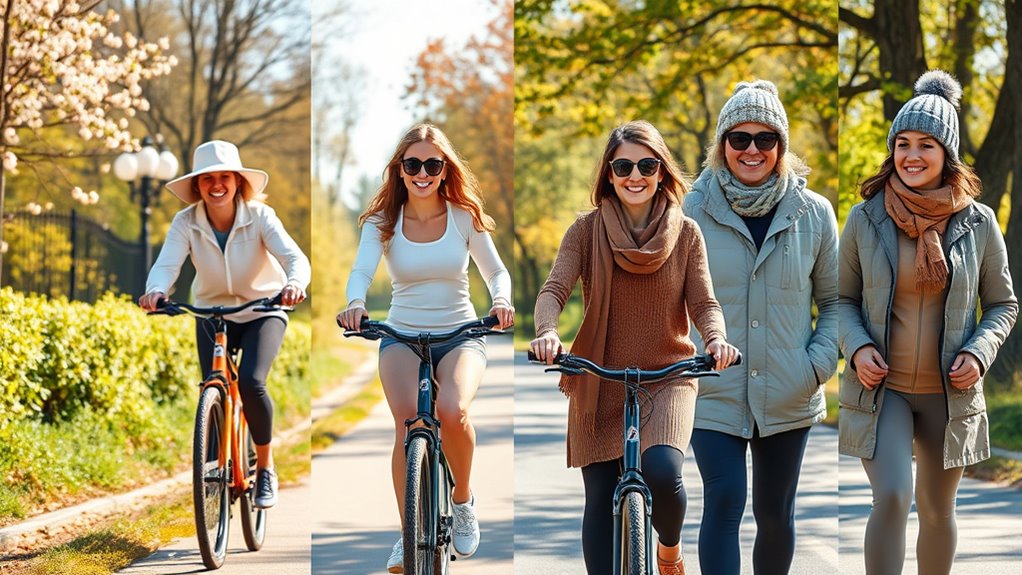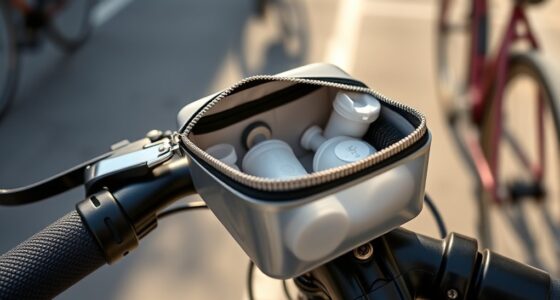For cycling year-round, dress in breathable, moisture-wicking fabrics in warmer months, and layer up with thermal, windproof, and waterproof gear in cold weather. During spring, choose lightweight jackets, arm warmers, and reflective accessories to stay flexible and safe. In summer, opt for sleeveless tops, lightweight shorts, and sun protection like hats and sunscreen. Keep safety essentials like helmets, gloves, and reflective accents in mind. Want to find out what best suits your season? Keep going to discover all the tips!
Key Takeaways
- Choose lightweight, breathable fabrics and bright or reflective gear for visibility during spring and summer rides.
- Layer with moisture-wicking base layers, insulating pieces, and windproof jackets for cold weather cycling.
- Adjust clothing and add waterproof shoes or covers during spring for rain protection and temperature variation.
- Wear quick-drying jerseys, shorts, and sun protection accessories like hats and sunscreen in summer.
- Prioritize safety with a well-fitted helmet, gloves, sunglasses, and reflective accents tailored to seasonal conditions.

Ever wondered what to wear for cycling to stay comfortable and safe? If you’re planning to hit the trails or commute through the city, choosing the right outfit for each season is key. Your goal is to stay comfortable while ensuring safety and freedom of movement. In warmer months, lightweight, breathable fabrics are your best friends. Opt for moisture-wicking jerseys or tops that pull sweat away from your skin, keeping you dry and cool. Pair these with padded cycling shorts or tight leggings designed for movement and comfort. Bright colors or reflective accents not only boost your style but also increase visibility to drivers and other cyclists. Don’t forget a well-fitted helmet, gloves, and sunglasses to protect your head, hands, and eyes from sun, debris, or wind.
Stay comfortable and safe with breathable fabrics, bright colors, and essential gear for cycling in any season.
As temperatures drop, layering becomes essential. Start with a moisture-wicking base layer that pulls sweat away from your skin. Add an insulating layer, such as a fleece or thermal jersey, to retain body heat. Over this, wear a windproof and water-resistant jacket to shield yourself from cold gusts and rain. Tights or thermal leggings provide warmth for your legs, and consider wearing thicker gloves to keep your hands warm without sacrificing dexterity. A good hat or headband under your helmet can also help retain heat, especially around your ears. Bright, reflective gear remains vital during darker winter days, making you more visible to others on the road. Incorporating UV protection into your clothing can also help prevent sun damage during winter outdoor rides.
In the spring, dress in layers that you can peel off as the day warms up. Mornings might be chilly, but afternoons could turn hot. Lightweight jackets and arm warmers are perfect for adjusting to changing temperatures. Breathable fabrics and moisture management remain important, so choose clothes that wick sweat and dry quickly. Waterproof shoes or shoe covers help keep your feet dry when spring showers arrive, and reflective accessories boost your visibility during those longer, cloudier days.
Summer cycling calls for even lighter clothing—think sleeveless tops or short-sleeve jerseys made from breathable, quick-drying materials. Shorts or lightweight tights keep you cool, and a wide-brim hat or cap under your helmet shields you from the sun. Don’t forget to apply sunscreen and carry plenty of water. For footwear, choose ventilated cycling shoes or sandals that provide proper grip and comfort. When the heat intensifies, lightweight, moisture-wicking socks are a good idea to prevent blisters and keep your feet dry.
Frequently Asked Questions
How Do I Stay Visible During Early Morning Rides?
To stay visible during early morning rides, you should wear bright, reflective clothing that catches drivers’ attention. Use LED bike lights on your front and rear, and consider adding reflective tape to your bike and gear. Always keep your lights on, even in low-light conditions, and avoid dark colors. By actively increasing your visibility, you guarantee a safer ride during those early hours.
What Are the Best Fabrics for Hot Weather Cycling?
Think of hot weather cycling fabrics as your personal breeze. Lightweight, breathable materials like moisture-wicking polyester or nylon keep you cool and dry, preventing sweat from sticking like glue. Look for fabrics with UPF protection to shield your skin from the sun. Avoid heavy cotton, which traps heat and moisture. These fabrics work like a second skin, helping you stay comfortable and focused on your ride.
How Should I Layer for Unpredictable Spring Weather?
You should layer smartly for unpredictable spring weather. Start with a moisture-wicking base layer to keep sweat away from your skin. Add a lightweight, breathable jersey or long-sleeve top that you can easily remove if it warms up. Carry a packable, waterproof jacket for sudden rain showers. Consider arm warmers or a vest for extra warmth without bulk, so you stay comfortable no matter how the weather shifts.
Are There Specific Shoes Recommended for Long-Distance Cycling?
For long-distance cycling, you should choose shoes that offer comfort, support, and efficiency. Look for lightweight, breathable cycling shoes with stiff soles to maximize power transfer. Opt for models with adjustable straps or cleats compatible with your bike pedals. Consider ventilation features to keep your feet cool during extended rides, and choose a fit that’s snug but not tight, preventing blisters and ensuring comfort over long distances.
How Do I Prevent Chafing With Cycling Apparel?
To prevent chafing while cycling, choose moisture-wicking, seamless clothing that fits well without being too tight. Apply anti-chafing balms or powders to sensitive areas before riding. Make sure your cycling shorts have a good chamois and are properly fitted. Adjust your gear if you notice any rubbing during your ride. Staying dry and comfortable helps avoid chafing, so change out sweaty clothes promptly and stay hydrated.
Conclusion
No matter the season, dressing appropriately makes your cycling experience safer and more comfortable. Did you know that over 60% of cyclists avoid riding in colder months due to inadequate clothing? By choosing the right gear for each season, you’ll stay warm, dry, and motivated to pedal year-round. Remember, investing in proper cycling apparel isn’t just about comfort—it’s about enjoying every ride, no matter the weather. So gear up and keep riding confidently through every season!









